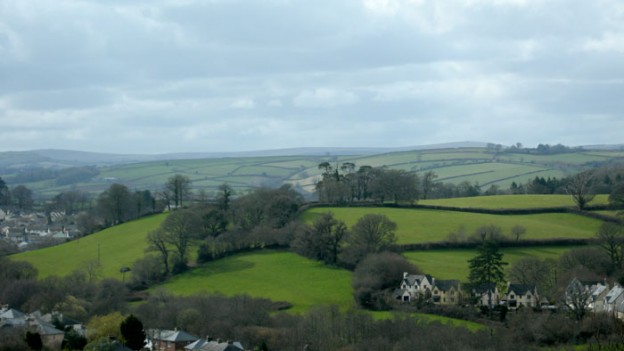It is roughly 100 days until the MA show here at the Dartington Campus of the University College Falmouth. It is a very strange experience—the Dartington Campus will move to the main college at the end of the year. There is a definitive sense of a winding down of place happening here that is both unique in the perspective it brings, and a bit of a burden.
I am preparing for another suite of paintings, trying to continue with the theme of painting landscapes where something is missing. In recent work, this has been mainly centered around the post-industrial condition, but that specific land condition is slim Totnes. I am attracted to the idea of an implied narrative through depicting an absence and how painting a local landscape can evoke discussion of simultaneous experiences of place.
In Space and Place: The Perspective of Human Experience, Yi Fu Tuan is discussing intimate experiences of place. Calling places “centers of value” (Tuan, p.18); the sense of place is developed by an accumulation of everyday events. Yet, intimate experiences are elusive to descriptive language.
Pictorial art and rituals supplement language by depicting areas of experience that words fail to frame; their use and effectiveness again vary from people to people. Art makes images of feeling so that feeling is accessible to contemplation and thought. Social chatter and formulaic communication, in contrast, numb sensitivity. Even intimate feelings are more capable of being represented than most people realize. The images of place, here sampled, are evoked by the imagination of perceptive writers. (namely an Isherwood passage) By the light of their art we are privileged to savor experiences that would otherwise have faded beyond recall. Here is a seeming paradox: thought creates distance and destroys the immediacy of direct experience, yet it is by thoughtful reflection that the elusive moments of the past draw near to us in a present reality and gain a measure of permanence.
(Ibid, p. 148)
Some potential sites that I will paint for the MA show include:
- A former, now vacant, squat near my flat. Squatters were evicted by court order. Landlord came in and smashed up the plumbing in an effort to make the places uninhabitable.
- A former forest that has just been logged by the forestry service. Neighbors are upset.
- A former quarry that is not used now, roped off for fear of falling rocks.
- A former swimming pool on the Dartington Estate, next to an abandoned school and tennis court.
I am still scouting around for further ideas. The above quote resonates with my approach to my current landscape painting work, specifically the last aspect. I believe I am trying to crystallize spaces that are fading or shine light on spaces that are hiding consequences.
Is it possible to have an intimate experience of the views here in Totnes? I am confounded on how to interpret the land from this perspective. I want to paint the vista’s because, I mean wow. How to frame it? Below is not natural, it is a beautiful landscape with an absence of the signs of labor that shaped it. What will this land look like when it starts to return to forest? Perhaps that is one way to try to paint it.

Tuan, Y. (2003) Space and Place : The Perspective of Experience. Minneapolis: University of Minnesota Press.
